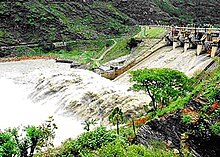| Pandoh Dam | |
|---|---|
 | |
| Country | India |
| Location | Mandi district |
| Coordinates | 31°40′17″N 77°04′01″E / 31.67139°N 77.06694°E |
| Status | Operational |
| Opening date | 1977 |
| Owner(s) | Beas Construction Board |
| Dam and spillways | |
| Type of dam | Embankment |
| Impounds | Beas River |
| Height | 76 m (249 ft) |
| Length | 255 m (837 ft) |
| Dam volume | 1,580,000 m3 (2,066,562 cu yd) |
| Spillway capacity | 9,939 m3/s (350,992 cu ft/s) |
| Reservoir | |
| Creates | Pandoh Lake |
| Total capacity | 41,000,000 m3 (33,239 acre⋅ft) |
| Surface area | 1.7 km2 (1 sq mi)[1] |
| Dehar Power Plant | |
| Coordinates | 31°24′37″N 76°51′43″E / 31.41018°N 76.86205°E |
| Commission date | 1977 |
| Hydraulic head | 335 m (1,099 ft) |
| Turbines | 6 x 165 MW (221,000 hp) Francis-type |
| Installed capacity | 990 MW (1,330,000 hp) |
The Pandoh Dam is an embankment dam on the Beas River in Mandi district of Himachal Pradesh, India. Under the Beas Project, the dam was completed in 1977 and its primary purpose is hydroelectric power generation. Part of a run-of-the-river power scheme, it diverts the waters of the Beas to the southwest through a 38 km (24 mi) long system of tunnels and channels. The water is used for power generation at the Dehar Power House before being discharged into the Sutlej River, connecting both rivers. The power house has an installed capacity of 990 MW.[2] The system diverts 256 cumecs (9000 cusecs) of Beas waters to the Satluj River. The project was completed in 1977.[3]
- ^ "India: National Register of Large Dams 2009" (PDF). Central Water Commission. Archived from the original (PDF) on 19 February 2018. Retrieved 22 November 2011.
- ^ "Dehar Power House". Bhakra Beas Management Board. Retrieved 25 November 2011.
- ^ "BBMB - Developmental History of Beas Project". Bhakra Beas Management Board. Retrieved 3 January 2016.
